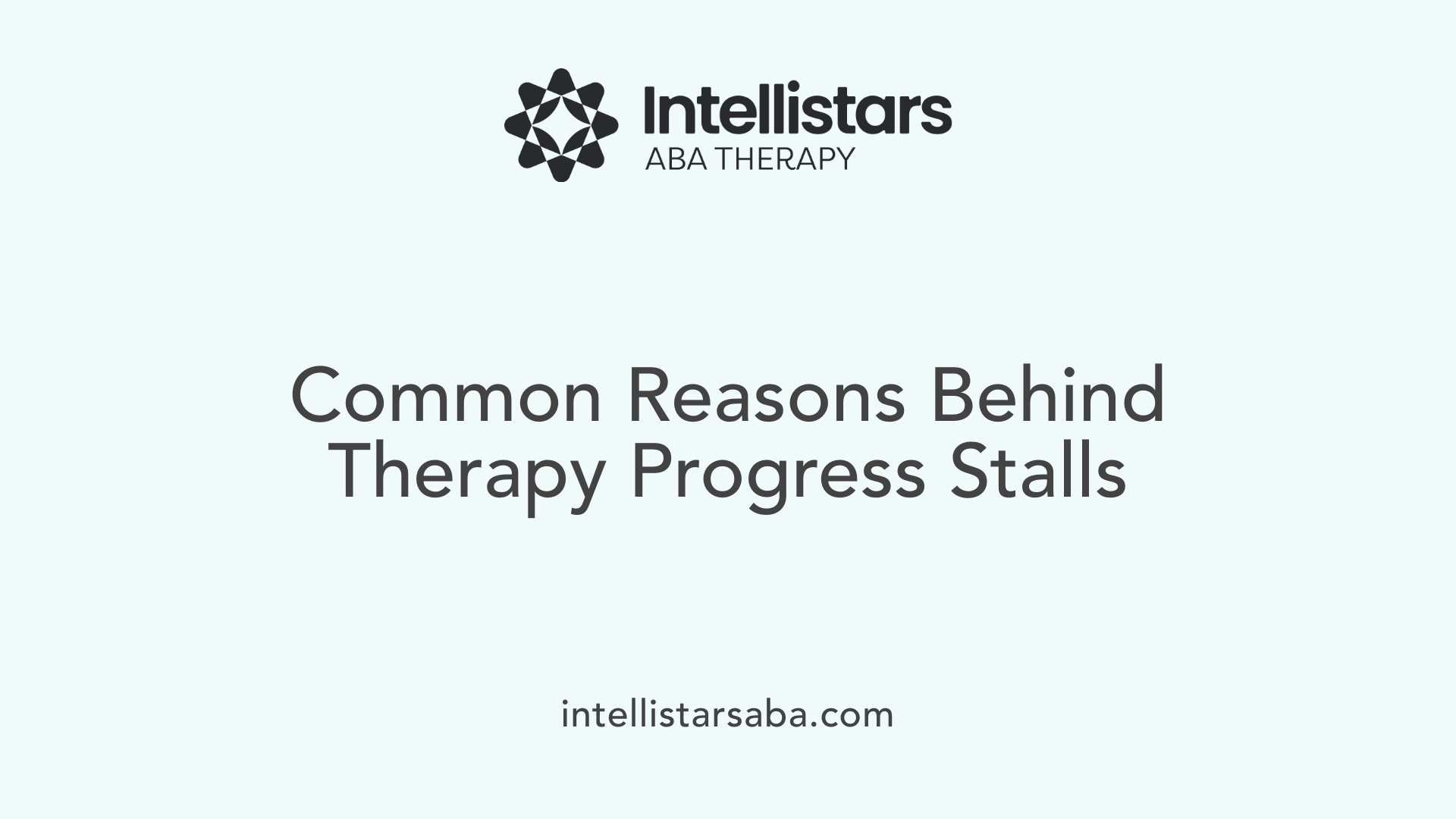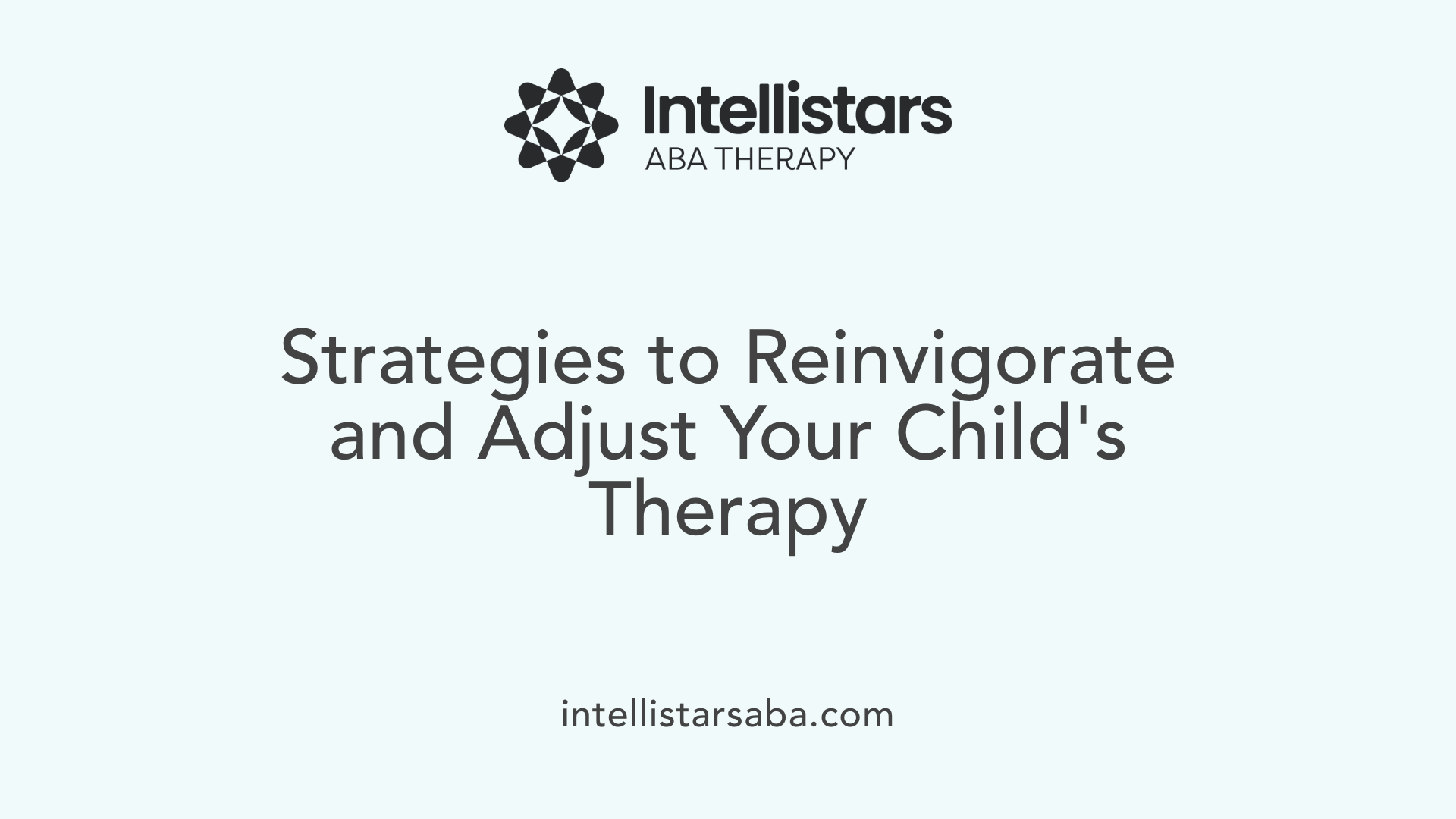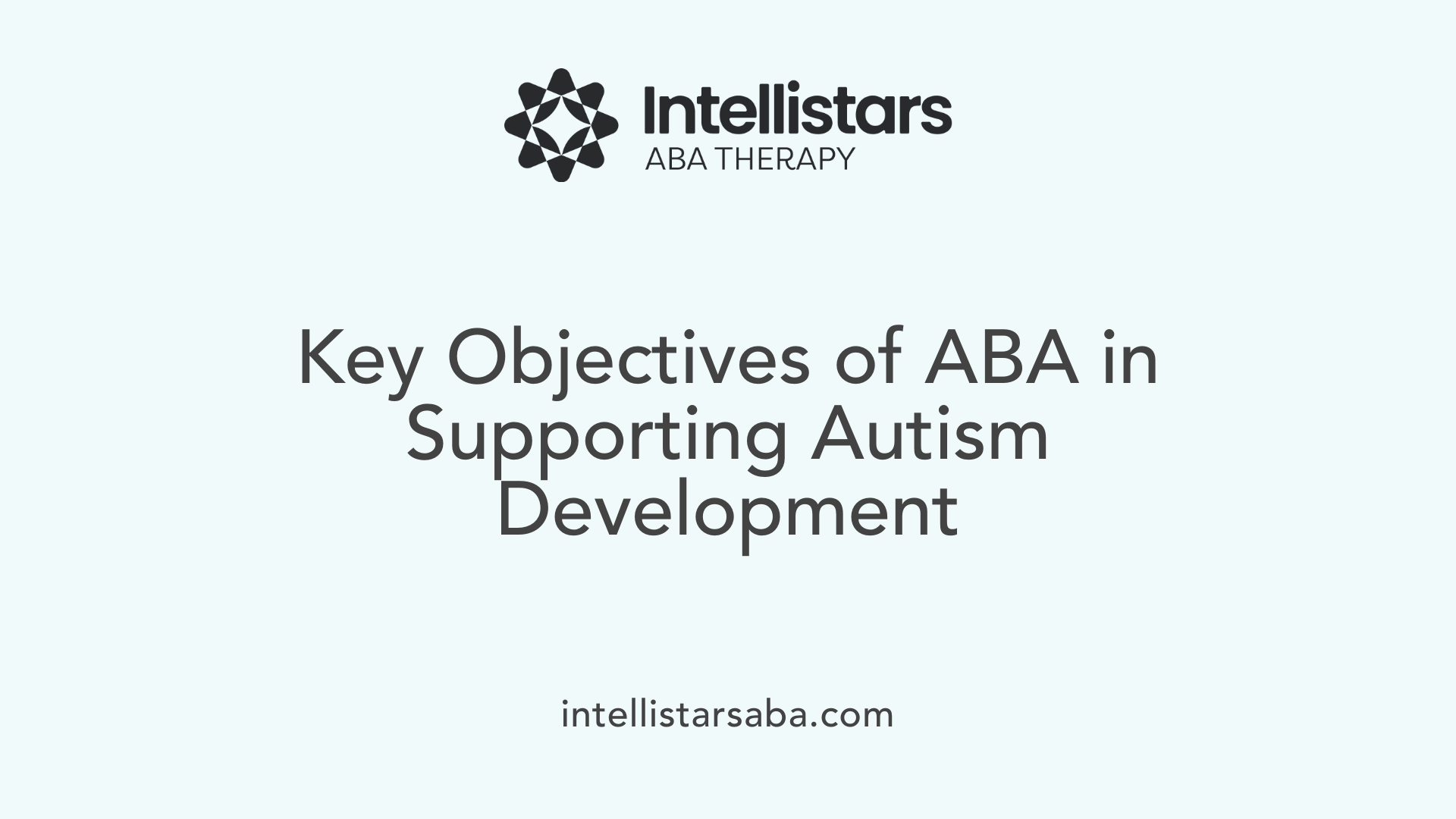Understanding Therapy Plateaus in ABA and Their Implications
ABA therapy is a cornerstone of early intervention for children with autism, aiming to foster skill development and reduce problematic behaviors through structured, evidence-based strategies. However, despite its proven effectiveness, many families encounter a common challenge: a plateau, where progress seems to stall. Recognizing the nature of therapy plateaus, understanding their causes, and exploring appropriate responses are crucial steps to ensure ongoing development and long-term success. This article delves into what happens when a child reaches a plateau in ABA therapy, how to identify its signs, why it occurs, and what strategies can be employed to re-energize the therapeutic process.
What is a Therapy Plateau and Its Significance?

Definition of a Plateau in ABA Therapy
A therapy plateau occurs when a child's progress in Applied Behavior Analysis (ABA) therapy slows down or temporarily stops. Despite ongoing sessions, improvements in skills such as communication, social interaction, and independence become less noticeable or appear to stagnate. This can be frustrating for families and therapists who are working diligently to foster development.
A plateau isn't necessarily a sign that therapy has failed. Instead, it often indicates that the child has reached a temporary ceiling with current methods or that additional challenges need addressing. Recognizing when a child's progress plateaus is crucial for adjusting goals and strategies effectively.
Implications of a Developmental Stall
A developmental stall can have significant implications if not appropriately managed. It might lead to frustration, decreased motivation, or behavioral resistance from the child. Without intervention, a plateau can hinder the acquisition of new skills or even result in regression.
In many cases, the child's difficulties—such as speech delays, motor impairments, or social challenges—are complex and multifaceted. When therapy reaches a plateau, it often signals that the existing approach no longer sufficiently addresses these intricacies.
To mitigate adverse effects, caregivers and therapists must analyze the potential causes behind the plateau. This includes examining environmental factors, the child's interests, and whether current strategies align with the child's evolving needs. Proactive steps to circumvent a development stall help ensure continued progress.
How Long Does ABA Therapy Typically Last, and When Might It Be Discontinued?
ABA therapy is a structured, intensive intervention that generally lasts between 3 to 5 years, depending on the child's needs and initial progress. The process begins with a comprehensive assessment conducted by a Board Certified Behavior Analyst (BCBA), who develops a personalized treatment plan.
Sessions typically occur 2 to 5 times per week, resulting in a total of 10 to 40 hours of therapy weekly. In the initial phases, full-time hours are common, gradually reducing as the child exhibits mastery over targeted skills.
Discontinuation of therapy generally happens when the child demonstrates consistent, generalized behaviors across different settings or when the goals outlined in the treatment plan are achieved. Regular reassessments help determine readiness to pause or conclude intensive intervention.
Deciding to end ABA therapy is a collaborative process involving parents, therapists, and the BCBA. It considers ongoing progress, potential for maintenance of skills, and whether additional therapies are warranted. Ultimately, the goal is to support lifelong independence and participation in society while respecting each child's unique developmental trajectory.
Signs of Developmental Stagnation or a Slowdown in Progress During ABA Therapy
Recognizing signs of stagnation early allows for timely adjustments. These signs include a persistent lack of improvement despite consistent intervention, such as no observable gains in communication, social skills, or independence over several months.
A plateau can also be indicated by regression, where a child loses previously mastered skills. Resistance or refusal to participate in therapy sessions, increased behavioral problems, or fatigue are additional clues.
Environmental factors—like changes in routine, sensory overload, or stress—may temporarily hinder progress but should not be mistaken for a genuine plateau.
Monitoring these signs enables caregivers and therapists to modify strategies swiftly, review goals, and ensure the selected approach remains effective.
How Can Caregivers and Therapists Address and Manage Therapy Plateaus?
Addressing a therapy plateau involves a collaborative review of the child's goals and current strategies. Tailoring interventions by incorporating more engaging, motivating activities such as preferred games or stimuli can re-energize the child's interest.
Breaking complex skills into smaller, easier steps ensures that progress remains achievable. Using data-driven assessments helps identify specific barriers, enabling targeted modifications.
Consistency across settings, including home, school, and community, is vital for reinforcing skills. Engaging parents and other caregivers in the process fosters a unified approach.
Maintaining flexibility, patience, and a positive attitude can help reduce frustration. Celebrating small successes keeps motivation high and diminishes resistance.
What Steps or Alternatives Are Available When Progress Stalls in ABA Therapy?
When progress stalls, the first step is often to reassess the child's individualized plan. Analyzing data collected during sessions can highlight specific areas where adjustments are needed.
Modifying reinforcement strategies, varying activities, or increasing the child's motivation can reignite progress. Collaborating closely with therapists, parents, and teachers ensures consistency and addresses environmental influences.
Utilizing visual supports, offering choices, and celebrating incremental successes help boost engagement. If setbacks persist, exploring alternative therapies like speech or occupational therapy, or conducting a comprehensive re-evaluation to tailor interventions, can provide new avenues for development.
By remaining adaptable and proactive, families and clinicians can help children overcome stagnation, sustaining momentum toward their developmental goals.
Understanding the Causes of a Plateau in Therapy Progress

What are some common reasons why a child's progress may plateau during ABA therapy?
Progress in ABA therapy can sometimes slow down or come to a standstill. This stagnation often has underlying causes that need to be identified to plan effective next steps.
One of the main reasons is the limitations inherent in using a single-approach program. Many early ABA interventions focus on specific skills, but if a child's difficulties are widespread and involve multiple areas—such as speech, social skills, and motor development—a one-size-fits-all method might fall short.
Children with complex needs typically require a mix of strategies tailored to their unique challenges. Relying solely on one approach without adapting to diverse developmental hurdles can limit progress.
Physical or neurological conditions can also interfere with specific therapy techniques. For example, sensory processing issues or neurological impairments might reduce a child's responsiveness to certain behavioral interventions, obstructing skill acquisition.
Further, children may reach the limits of what a particular program can achieve. When a child has advanced beyond the scope of initial goals, or when difficulties span various domains, the traditional ABA framework might need modification or supplementation.
Progress stalls when programs are not sufficiently flexible to adapt to the child's evolving needs or when a far-reaching, individualized plan isn't in place.
Is a child's development hindered by factors other than innate limitations?
In many cases, a child's development might appear to plateau, but this isn’t necessarily due to innate limitations or parenting styles. Instead, it often results from the current intervention's inability to fully address the child's complex profile.
If a therapy is too narrow or not responsive enough, it may fail to promote growth across all necessary areas. Children could be unintentionally held back by programs that do not consider their full spectrum of challenges.
Therefore, reassessment and tailored modifications are vital. When the intervention matches the child's specific needs, development can continue more effectively.
By continuously evaluating progress and adjusting techniques accordingly, professionals and families can help children break through stagnation points and reach their developmental potential.
How to Re-energize and Adjust Interventions After a Plateau

What are effective strategies for re-energizing therapy when a child reaches a plateau?
When progress slows or halts, it's essential to revisit and modify the intervention approach. Effective methods start with a comprehensive assessment and close observation to uncover the specific reasons behind the stagnation. By analyzing which areas of difficulty persist, caregivers and professionals can identify if the current strategies are no longer matching the child's evolving needs.
Adjusting goals to reflect the child's recent capabilities helps in maintaining motivation. For example, breaking down complex skills into smaller, more manageable steps can prevent frustration and promote a sense of achievement.
To re-ignite development, incorporating diverse tools and strategies is beneficial. Play-based, natural environment, and interest-based approaches tend to be more engaging for children, encouraging spontaneous learning. Programs like Growing Minds provide a structured way to assess needs, set personalized goals, and introduce flexible teaching methods tailored to each child's unique profile.
Options for intervention include in-person sessions, remote training, or home-based programs, offering convenience and customization. Using a variety of engaging activities, alongside techniques such as positive reinforcement, ensures that therapy remains stimulating and constructive.
By applying these strategies—assessment, goal adjustment, and varied methods—caregivers and therapists can successfully move past stagnation and support continued growth in children with autism.
What is the role of assessment in overcoming stagnation, and how can goals be adjusted?
Assessment plays a critical role in identifying why progress has stalled. It involves detailed observation, data collection, and analysis to pinpoint the child's current challenges and strengths. This process helps determine whether the existing program addresses all relevant areas or if certain complexities—such as speech, motor skills, or social interaction—are not being adequately supported.
With this informed understanding, goals can then be adjusted to better fit the child's developmental stage and interests. For example, if a child shows difficulty in social skills but is motivated by certain games or topics, goals can be modified to incorporate these interests. This tailored approach keeps the child engaged and reduces frustration.
Regular re-evaluation ensures that the program remains aligned with the child's changing needs. Dynamic goal setting prevents stagnation by maintaining a balance between achievable challenges and developmental progression, fostering continuous improvement even after a plateau.
Use of varied tools and strategies
Implementing a mix of teaching methods can dramatically improve outcomes after a development slowdown. Play-based interventions, natural environment teaching, and interest-driven activities make learning enjoyable and relevant.
Utilizing technology, visual supports, and community-based activities can diversify the learning experience. For instance, incorporating apps for communication skills or social stories might rekindle interest.
Creating individualized plans through programs like Growing Minds offers a structured yet flexible framework. These initiatives assess, personalize goals, and adapt strategies—be it through face-to-face sessions, online methods, or home programs—ensuring continued engagement.
Tailored approaches like Growing Minds
The Growing Minds program exemplifies personalized intervention by providing assessment services, setting specific goals, and adjusting teaching approaches based on ongoing evaluations. It emphasizes a flexible methodology that can include in-person, telehealth, or home-based interventions.
Families benefit from initial consultation packages that offer a comprehensive overview and tailored plans to address stagnation. The program also emphasizes involving caregivers in the process, ensuring skills generalize beyond therapy sessions.
In summary, when progress stalls, a multi-faceted approach involving assessment, adaptable goals, and diverse strategies—exemplified by programs like Growing Minds—can help children regain momentum in their developmental journey. These methods not only promote continuous growth but also enhance engagement, making therapy a positive, ongoing experience for the child.
The Role of Data and Continuous Assessment in Progress
Monitoring developmental milestones is a fundamental component of effective autism therapy, particularly within programs like Applied Behavior Analysis (ABA). Regular assessments help determine whether a child's skills are advancing, stagnating, or regressing. This ongoing process involves collecting detailed data during therapy sessions, which provides a factual basis for evaluating progress.
Data collection includes tracking specific behaviors, responses to interventions, and the achievement of set goals. By analyzing these data points, therapists can identify patterns that might indicate a plateau or slowdown in development. Recognizing such trends early allows for timely adjustments, preventing the loss of skills and promoting continuous progress.
Adjusting interventions is crucial when progress stalls. Based on the collected data, therapists and caregivers can modify goals, choose different reinforcement strategies, or incorporate new techniques to better suit the child's current needs. This flexibility ensures that therapy remains personalized and effective, preventing frustration for the child and optimizing learning.
The collaborative evaluation process involves regular communication among therapists, parents, teachers, and other involved professionals. By sharing observations and data, all parties can interpret changes accurately and make informed decisions. This teamwork supports tailored intervention adjustments, ensuring strategies are aligned with the child's evolving profile.
| Monitoring Aspect | Impact on Therapy | Details |
|---|---|---|
| Developmental milestones tracking | Identifies progress or stagnation | Continuous assessment helps ensure the child's progress stays on course |
| Data collection & analysis | Guides precise adjustments | Quantitative data informs modifications in interventions |
| Interdisciplinary collaboration | Enhances accuracy of evaluations | Combines insights from therapists, parents, and educators |
The importance of data collection in managing ABA therapy progress cannot be overstated. It empowers therapists and families to make evidence-based decisions aimed at fostering meaningful development. Regular assessments ensure that interventions are responsive, adaptive, and aligned with each child's unique journey. This structured, data-driven approach helps maximize outcomes and supports sustained growth in children with autism, even when progress appears to slow.
Outcomes and Consequences of a Child Reaching a Plateau
What are the outcomes or consequences if a child reaches a plateau in ABA therapy?
When a child's development stalls, particularly within ABA therapy, several outcomes may occur if the plateau is not addressed promptly. One significant concern is potential skill regression. This risk is especially high if therapy is suddenly halted or if strategies are not adapted to a child's evolving needs.
Skill stagnation can result in a slowdown or complete halt in learning new abilities, including communication skills, social interaction, or adaptive behaviors such as self-care. For example, a child might stop showing progress in speaking or engaging with peers.
Prolonged stagnation can impact a child's confidence and independence. When children do not see ongoing success or improvement, they may become discouraged, which can reduce their motivation to participate in learning activities. This decreased motivation can further hinder their development.
In the long run, if developmental progress is not maintained or revitalized, there might be lasting effects on overall growth. These include difficulties in school, reduced participation in social activities, and challenges adapting to daily life demands.
However, with strategic modifications to therapy—such as reassessing goals, introducing new tools, or adjusting teaching methods—therapists and families can help children recover from stagnation. Prompt intervention helps sustain momentum and facilitates continued progress.
Are there long-term effects associated with developmental stalls?
Long-term consequences of developmental stalls can be significant if they remain unaddressed over extended periods. Children may experience delayed achievement of developmental milestones like walking, talking, or social independence.
Persistent stagnation could lead to reduced abilities in functioning independently, such as managing daily routines or communicating effectively in social contexts. These challenges can affect integration into educational settings and community life.
Children who experience long-term stalls may also face increased difficulty in developing adaptive skills crucial for independence, like self-care and problem-solving.
Nonetheless, early intervention adjustments and continued support can help minimize these negative outcomes. By recognizing signs of stagnation early and modifying therapies accordingly, children have a better chance to catch up and reach their full potential.
| Aspect | Potential Impact | Mitigation Strategies |
|---|---|---|
| Skill Regression | Loss or delay of acquired skills | Continuous assessment, therapy adjustment, reinforcement |
| Confidence and Independence | Lower self-esteem, reduced motivation | Positive reinforcement, personalized goals |
| Long-term Developmental | Delays in milestones, social, and adaptive skills | Early detection, ongoing therapy, family involvement |
Understanding these outcomes emphasizes the importance of vigilant monitoring and proactive adjustments in therapy. Regular evaluations and collaborative efforts between parents, therapists, and educators are critical to supporting sustained developmental progress.
Supporting Children and Families Through Boundaries and Transitions
What is the role of structured breaks or transitions in therapy, especially during a plateau?
When a child's progress with autism therapy has slowed or plateaued, implementing structured breaks can be beneficial. These breaks, when meticulously planned and supervised by a qualified BCBA (Board Certified Behavior Analyst), serve to reduce frustration and prevent burnout—for both the child and their caregivers.
A well-designed transition plan involves gradual adjustments, such as decreasing therapy hours over a period, and reinforcing existing skills at home. This approach helps maintain the child's gains and minimizes the risk of skill regression. During these breaks, continuing routines, engaging in other therapies like speech or occupational therapy, and providing familiar environments play a vital role in supporting ongoing development.
Reassessing the child's needs before reinitiating full-scale therapy allows therapists to tailor the approach—whether adjusting goals, strategies, or tools—to better fit the child's current developmental stage. This careful planning ensures a smooth return to progress, making the transition less disruptive and more effective.
How can families support their child's development during therapy transitions?
Family involvement is crucial during therapy transitions—a period that can sometimes be stressful or uncertain for children. Parents and caregivers can foster development by maintaining consistent routines, which provide a sense of security and predictability.
Engaging in complementary therapies, such as speech or occupational therapy, alongside formal ABA programs helps sustain progress. Implementing strategies learned during parent training, like prompting and reinforcement, reinforces skills and promotes confidence.
Preparation strategies, including using visual supports or social stories, can help children understand upcoming changes, reducing anxiety and resistance. Additionally, gradual reintegration into therapy sessions—starting with brief visits or play-based interactions—can ease children back into structured learning.
Regular communication with therapists about the child’s progress ensures that therapy plans remain adapted to their evolving needs. This ongoing collaboration helps maximize the effectiveness of interventions, supporting sustained growth even amid transitions.
| Aspect | Family Role | Description |
|---|---|---|
| Routine Maintenance | Support consistency | Keeping daily routines stable to provide comfort and predictability |
| Engagement in supplementary therapies | Enhance progress | Participating in speech, OT, or other therapies during transitions |
| Visual supports | Prepare child | Using visual schedules or social stories to explain upcoming changes |
| Collaboration | Ensure relevance | Regularly communicating with therapists to adapt strategies |
| Gradual reintegration | Reduce anxiety | Easing the child back into therapy with phased approaches |
Additional Insights on Transition Strategies
Research indicates that careful planning of therapy breaks and transitions can prevent regression and even foster new skills. A proactive approach, involving both therapists and families, creates a supportive environment that promotes continued growth.
For many families, understanding that therapy is a dynamic process helps reduce frustration. It’s important to remember that pauses or adjustments are part of adapting to each child's unique pace and needs.
Adopting a flexible, informed attitude toward therapy transitions ensures children with autism receive ongoing support tailored to their developmental journey. This holistic approach encourages resilience, independence, and long-term success.
The Role and Goals of ABA in Autism Support

Building Skills and Reducing Behaviors
ABA therapy centers on helping children with autism develop essential skills and minimize problematic behaviors. By utilizing techniques grounded in the science of learning, ABA aims to foster improvements in communication, social interaction, and daily functioning. It includes strategies such as positive reinforcement—rewarding desired behaviors to encourage their repetition—and comprehensive data collection to monitor progress.
Core ABA approaches include discrete trial training (DTT), pivotal response training (PRT), and natural environment training (NET). These methods are adapted to meet each child's unique needs and are implemented in various settings, including home, school, and community environments.
Progress is regularly assessed through detailed data, with therapists and parents working collaboratively to make ongoing adjustments. This personalized process helps identify which techniques work best for the child, promoting consistent growth in essential life skills.
Promoting Independence and Participation
A central aim of ABA is to enable children to participate more fully in society and everyday life. Therapists focus on teaching functional skills such as communication, self-care, and social interaction, which empower children to navigate their environment more independently.
Effective ABA programs focus on individualized goal-setting, often involving direct involvement from families. Training parents to implement strategies ensures that skill development continues beyond formal sessions. When progress stalls, programs like Growing Minds assess the child's specific difficulties and adjust methods accordingly.
Research supports early intervention, ideally starting before age two, for better outcomes. Early therapy can significantly reduce symptom severity, facilitating smoother integration into less restrictive educational and social settings.
Neurodiversity and Respect Individual Differences
Modern interpretations of ABA prioritize respecting each child's neurodivergent identity. This involves tailoring interventions to align with the child's preferences, interests, and strengths rather than trying to make them conform to neurotypical standards.
Contemporary ABA practices emphasize providing choices, fostering joy, and engaging children through play-based and naturalistic approaches. These methods aim to make learning enjoyable, thereby increasing motivation and participation.
While traditional ABA focused heavily on suppression of behaviors, current practice recognizes the importance of balancing skill development with acceptance of natural tendencies. This shift acknowledges that behaviors often linked to neurodiversity—such as stimming—can serve important functions and should not be solely viewed as problematic.
This respectful approach aligns with the broader neurodiversity movement, which values diverse ways of thinking, perceiving, and interacting with the world. The ultimate goal is to support children in leading fulfilling lives with independence and self-advocacy.
| Aspect | Traditional ABA Focus | Modern, Respectful ABA | Details |
|---|---|---|---|
| Objectives | Behavior suppression | Skill building & acceptance | Focus on support without suppression of natural behaviors |
| Approach | Repetition, conformity | Personalized, interest-based | Tailored to child’s preferences & strengths |
| Engagement | Rewards & reinforcement | Choice & joy | Prioritizes motivation and enjoyment |
| Respect for identity | Less emphasized | Central element | Values neurodivergent ways of being |
| Intervention style | Structured, often rigid | Flexible, playful | Adaptable to child’s needs & environment |
Understanding and implementing these diverse strategies helps create a supportive environment where children with autism can thrive, grow skills at their own pace, and participate actively in all aspects of life.
Moving Forward with Informed Support Strategies
Understanding what happens when a child reaches a plateau in ABA therapy is essential for fostering continued growth and development. Recognizing signs of stagnation, identifying underlying causes, and implementing tailored adjustments can effectively re-energize therapy sessions. Tools like data collection, reassessment, and flexible strategies ensure that intervention remains responsive to each child's changing needs, thereby minimizing long-term negative outcomes such as regression or decreased confidence. Through collaborative efforts among families, therapists, and educators—utilizing comprehensive assessment and adherence to best practices—children with autism can overcome developmental stalls, continue acquiring vital skills, and achieve greater independence and participation in their communities.
References
- Children Whose Progress with Autism Has Slowed
- Applied Behavior Analysis (ABA) | Autism Speaks
- When to Pause ABA Therapy (and When Not To) - All Star ABA
- The Controversy Around ABA - Child Mind Institute
- Pediatric ABA Therapy: Guide to When, Why & How Much?
- Can one hour per week of therapy lead to lasting changes in young ...
- What Parents Need to Know About ABA Therapy for Autism






